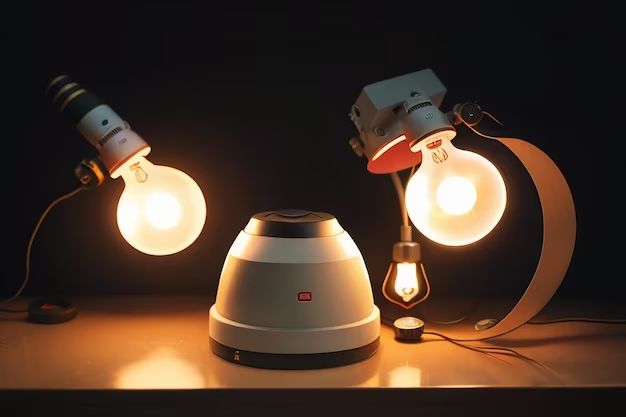When it comes to heat lamps, the type of bulb they use can vary depending on the specific model and intended function. However, most heat lamps designed for home or commercial use take incandescent, halogen, or ceramic infrared bulbs. Let’s take a closer look at each of these bulb options to better understand what they are and how they work in heat lamps.
Page Contents
Incandescent Bulbs
Incandescent bulbs are one of the most common types used in heat lamps. They work by heating a filament wire to a high temperature until it glows. This in turn produces both visible light and infrared radiation or heat. Standard incandescent bulbs can be used in some basic heat lamp fixtures. However, there are also speciality incandescent bulbs made specifically for heat lamps.
These bulbs are designed to maximize infrared radiation output. They have filaments made of different materials and coils that are optimized for heat production. Common wattages for incandescent heat lamps range from 250W to 500W. The higher the wattage, the more heat they can generate. Incandescents are inexpensive and readily available. However, they are less efficient than other bulb options.
Benefits of Incandescent Bulbs
- Inexpensive purchase cost
- Easy to find
- Work with standard light sockets
Drawbacks of Incandescent Bulbs
- Less efficient than halogen or infrared
- Short lifespan
- More prone to burning out
Halogen Bulbs
Halogen bulbs are another common choice for heat lamps. They are a type of incandescent bulb that uses halogen gas instead of a traditional filament. This allows them to burn brighter and hotter while being more energy efficient. Like incandescents, halogen bulbs produce both visible light and infrared heat radiation.
For heat lamps, higher wattage halogen bulbs between 500W to 1,000W are typically used. The intense heat from these bulbs makes them well-suited for applications like commercial food warming lights. However, the high temperatures also mean a greater fire risk if proper precautions are not taken. Touching a hot halogen bulb can lead to severe burns.
Benefits of Halogen Bulbs
- Brighter light intensity
- Greater energy efficiency than incandescents
- Longer lifespan
Drawbacks of Halogen Bulbs
- High operating temperatures
- Higher cost than incandescents
- Must be used carefully to avoid fire risks
Ceramic Infrared Bulbs
Ceramic infrared bulbs, also sometimes called heat lamps bulbs, emit a warmer wavelength of infrared than halogen and incandescent bulbs. They work by passing electricity through a solid ceramic material rather than a traditional filament. As the ceramic heats up, it releases longer wavelength infrared rays that are experienced as radiant heat.
Very little visible light is produced by these specialized bulbs. But they are extremely efficient at converting electricity to heat. Power levels between 250W to 500W are typical for ceramic infrared bulbs used in heat lamps. Their heat output remains constant regardless of ambient temperature, unlike incandescent and halogen bulbs.
Benefits of Ceramic Infrared Bulbs
- Emit the longest infrared wavelengths
- Remain efficient in cold environments
- Long lifespan rating
Drawbacks of Ceramic Infrared Bulbs
- Higher initial cost
- Take longer to reach maximum temperature
- Brittle construction
Comparing Bulb Types
To see how these three main bulb varieties stack up, here is a helpful comparison table:
| Bulb Type | Lifespan | Heat Output | Light Output | Cost |
|---|---|---|---|---|
| Incandescent | 750-1,000 hours | Medium-High | Medium-High | Low |
| Halogen | 2,000-4,000 hours | Very High | Very High | Medium |
| Ceramic Infrared | Up to 20,000 hours | High | Very Low | High |
As you can see, each bulb has its own advantages and best uses. Incandescent bulbs are affordable and readily available. Halogens offer brighter light and heat. Ceramic infrared bulbs maximize heating efficiency in specific heat lamp applications.
Choosing the Right Bulb
So which is the best bulb for your heat lamp? Here are some tips on selecting the right one:
- Consider your primary goal – do you need strong lighting or mainly efficient heating?
- Calculate the bulb wattage required based on your heat lamp fixture size.
- Factor in operating costs – infrareds cost more but use less electricity over time.
- Make sure the bulb fits properly in the socket and is compatible with dimmers/controls.
- Check that higher wattage bulbs won’t overheat your fixture.
- Look at lifespan ratings to determine cost effectiveness.
- Choose infrared for heating efficiency, halogens for combined light and heat, or incandescents if cost is the priority.
Installing the wrong bulb type or wattage in a fixture can lead to premature bulb failure or even dangerous overheating. Always consult the heat lamp manufacturer’s guidelines before replacing bulbs. Proper wiring and sockets are also crucial for safety. With the right bulb and proper installation, a heat lamp can provide beneficial directed warmth and lighting for years.
Conclusion
Heat lamps are versatile devices that can be customized with different bulbs to meet specific lighting and heating needs. While incandescent bulbs are the most affordable option, halogen and ceramic infrared bulbs offer greater efficiency and longevity. Consider the environment the lamp will be used in, the temperature range needed, and operational costs before selecting a bulb type. With this understanding of the differences between incandescent, halogen and infrared heat lamp bulbs, you can choose the right one to take advantage of all the benefits heat lamps offer.
